英语中的否定句
- 格式:doc
- 大小:46.50 KB
- 文档页数:2

初中英语否定句用法归纳-CAL-FENGHAI.-(YICAI)-Company One1初中英语否定句用法归纳一、用一般否定词not,否定了英语中的绝大多数句子。
1、对be动词的否定,在后面加上not。
He is not a student.2、对谓语动词的否定,根据人称和时态在前面加上助动词don’t, doesn’t, didn’t。
He didn’t watch TV last night.3、对助动词的否定,在后面加上not。
He has not been to Shanghai before.5、对need, dare的否定:need和dare除了可以用作情态动词外,还可以用作普通的行为动词,即除了上表中的否定形式外,还有don’t need to和don’t dare to的否定形式。
在实际运用中需注意。
6、对has/have 的否定:have在现在完成时中为助动词,其否定形式在后面加上not,作为“有”的意思,其否定形式也可以在后面加not,即hasn’t和haven’t,但该用法在课本中没有出现。
所以,不管have作为什么意思,只要不是用作助动词构成现在完成时,其否定形式一律用don’t/doesn’t/didn’t have。
7、不定式的否定:在前面加上not。
即:ask / tell /…sb not to do sth。
8、动名词的否定:在前面加上not。
即:worry about not doing。
9、祈使句的否定:在句首加上Don’t。
如有please,在please后面加上don’t。
Please don’t talk in class.二、通过绝对否定词否定。
此类词如下:never, no, no one, nobody, nothing, nowhere, none, neither, neither…nor…, no more, no longer。
☆特别提醒:1、绝对否定词no相当于not…any…。
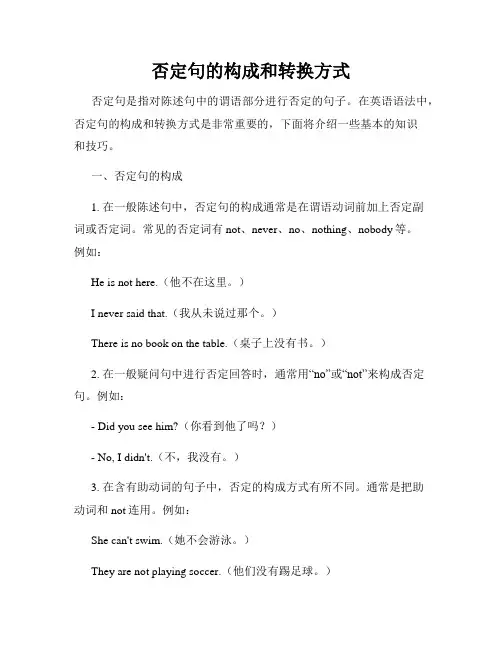
否定句的构成和转换方式否定句是指对陈述句中的谓语部分进行否定的句子。
在英语语法中,否定句的构成和转换方式是非常重要的,下面将介绍一些基本的知识和技巧。
一、否定句的构成1. 在一般陈述句中,否定句的构成通常是在谓语动词前加上否定副词或否定词。
常见的否定词有not、never、no、nothing、nobody等。
例如:He is not here.(他不在这里。
)I never said that.(我从未说过那个。
)There is no book on the table.(桌子上没有书。
)2. 在一般疑问句中进行否定回答时,通常用“no”或“not”来构成否定句。
例如:- Did you see him?(你看到他了吗?)- No, I didn't.(不,我没有。
)3. 在含有助动词的句子中,否定的构成方式有所不同。
通常是把助动词和not连用。
例如:She can't swim.(她不会游泳。
)They are not playing soccer.(他们没有踢足球。
)二、否定句的转换方式1. 直接否定转换直接否定转换是通过在原句中添加或删除否定词来实现的。
例如:I have a car.(我有一辆车。
)→ I don't have a car.(我没有车。
)She always wakes up early.(她总是早起。
)→ She never wakes up early.(她从不早起。
)2. 倒装否定转换倒装否定转换是通过将助动词和主语倒装来实现的。
例如:He has finished his homework.(他完成了作业。
)→ Has he not finished his homework?(他没有完成作业吗?)You should go to bed early.(你应该早点睡觉。
)→ Shouldn't you go to bed early?(你不应该早点睡觉吗?)3. 去除助动词与情态动词的否定转换当否定句中含有助动词或情态动词时,可以通过去除该助动词或情态动词的方式来实现转换。
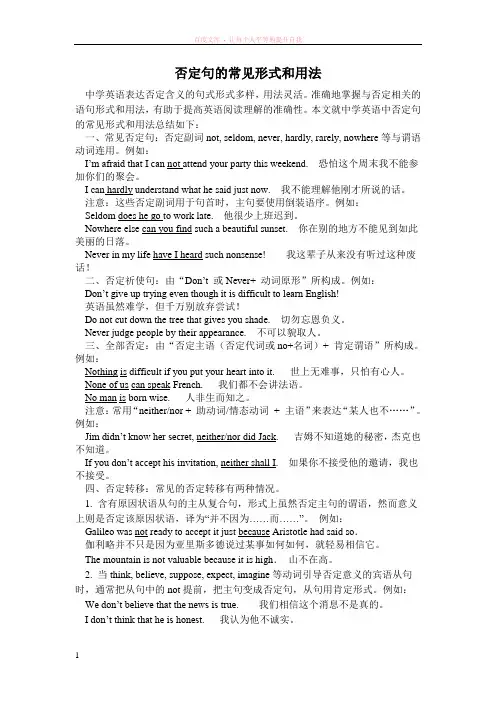
否定句的常见形式和用法中学英语表达否定含义的句式形式多样,用法灵活。
准确地掌握与否定相关的语句形式和用法,有助于提高英语阅读理解的准确性。
本文就中学英语中否定句的常见形式和用法总结如下:一、常见否定句:否定副词not, seldom, never, hardly, rarely, nowhere等与谓语动词连用。
例如:I’m afraid that I can not attend your party this weekend. 恐怕这个周末我不能参加你们的聚会。
I can hardly understand what he said just now. 我不能理解他刚才所说的话。
注意:这些否定副词用于句首时,主句要使用倒装语序。
例如:Seldom does he go to work late. 他很少上班迟到。
Nowhere else can you find such a beautiful sunset. 你在别的地方不能见到如此美丽的日落。
Never in my life have I heard such nonsense! 我这辈子从来没有听过这种废话!二、否定祈使句:由“Don’t 或Never+ 动词原形”所构成。
例如:Don’t give up trying even though it is difficult to learn English!英语虽然难学,但千万别放弃尝试!Do not cut down the tree that gives you shade. 切勿忘恩负义。
Never judge people by their appearance. 不可以貌取人。
三、全部否定:由“否定主语(否定代词或no+名词)+ 肯定谓语”所构成。
例如:Nothing is difficult if you put your heart into it. 世上无难事,只怕有心人。
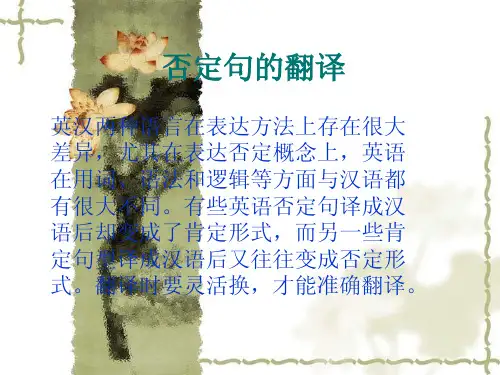
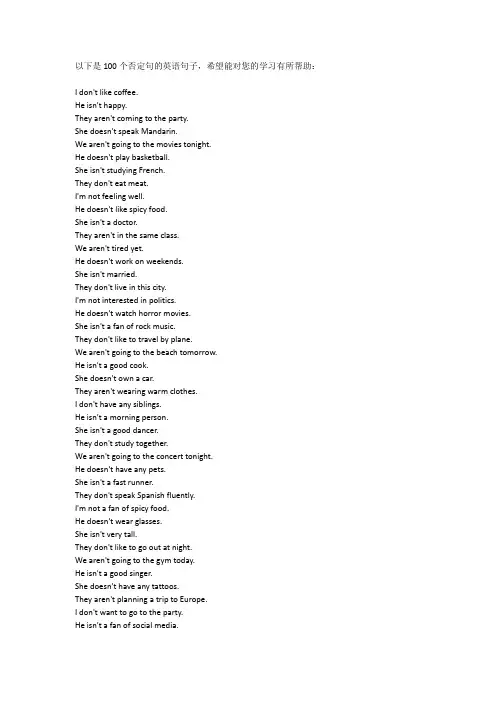
以下是100个否定句的英语句子,希望能对您的学习有所帮助:I don't like coffee.He isn't happy.They aren't coming to the party.She doesn't speak Mandarin.We aren't going to the movies tonight.He doesn't play basketball.She isn't studying French.They don't eat meat.I'm not feeling well.He doesn't like spicy food.She isn't a doctor.They aren't in the same class.We aren't tired yet.He doesn't work on weekends.She isn't married.They don't live in this city.I'm not interested in politics.He doesn't watch horror movies.She isn't a fan of rock music.They don't like to travel by plane.We aren't going to the beach tomorrow.He isn't a good cook.She doesn't own a car.They aren't wearing warm clothes.I don't have any siblings.He isn't a morning person.She isn't a good dancer.They don't study together.We aren't going to the concert tonight.He doesn't have any pets.She isn't a fast runner.They don't speak Spanish fluently.I'm not a fan of spicy food.He doesn't wear glasses.She isn't very tall.They don't like to go out at night.We aren't going to the gym today.He isn't a good singer.She doesn't have any tattoos.They aren't planning a trip to Europe.I don't want to go to the party.He isn't a fan of social media.They don't like to watch TV.We aren't going to eat at that restaurant.He doesn't play video games.She isn't a vegetarian.They don't enjoy hiking.I'm not in the mood for jokes.He isn't interested in history.She isn't very organized.They don't have any children.We aren't going to play tennis tomorrow.He doesn't like to shop.She isn't good at math.They don't like chocolate.I don't have a lot of free time.He isn't a good driver.She isn't a fan of horror movies.They don't enjoy going to the beach.We aren't going to the park today.He doesn't like to cook at home.She isn't very outgoing.They don't listen to classical music.I'm not very good at sports.He isn't a fan of reality TV.She isn't a good public speaker.They don't like spicy food.We aren't going to the museum this weekend. He isn't a fan of pop music.She isn't a morning person.They don't like to go out to eat.I'm not a fan of action movies.He isn't very artistic.She isn't very talkative.They don't like to dance.We aren't going to the park tomorrow.He doesn't enjoy going to the gym.She isn't a fan of rap music.They don't like to stay up late.I don't like to drive in traffic.He isn't good at fixing things.She isn't interested in politics.They don't enjoy going to the movies.We aren't going to the mall today.He doesn't like to swim.They don't like to travel by train.I'm not a fan of the cold weather.He isn't very adventurous.She isn't very patient.They don't like to go to the zoo.We aren't going to the aquarium next week. He doesn't like to go to the doctor.She isn't a fan of heavy metal music.They don't like to go to the club.I'm not very good at playing instruments. He isn't a fan of romantic movies.She isn't very artistic.They don't like to watch sports on TV.。
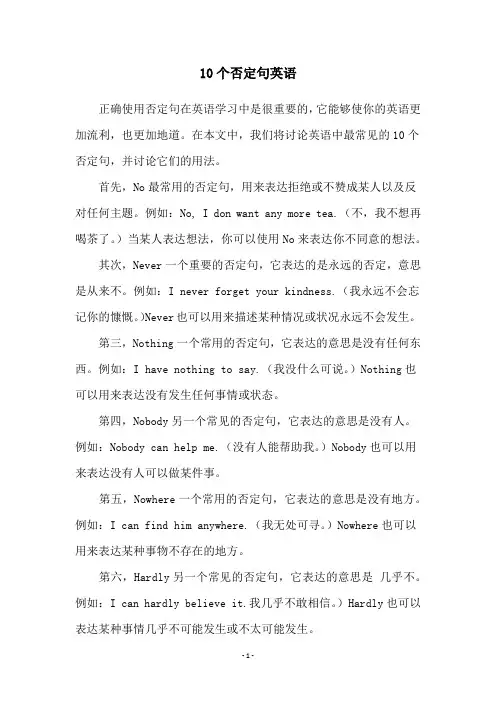
10个否定句英语正确使用否定句在英语学习中是很重要的,它能够使你的英语更加流利,也更加地道。
在本文中,我们将讨论英语中最常见的10个否定句,并讨论它们的用法。
首先,No最常用的否定句,用来表达拒绝或不赞成某人以及反对任何主题。
例如:No, I don want any more tea.(不,我不想再喝茶了。
)当某人表达想法,你可以使用No来表达你不同意的想法。
其次,Never一个重要的否定句,它表达的是永远的否定,意思是从来不。
例如:I never forget your kindness.(我永远不会忘记你的慷慨。
)Never也可以用来描述某种情况或状况永远不会发生。
第三,Nothing一个常用的否定句,它表达的意思是没有任何东西。
例如:I have nothing to say.(我没什么可说。
)Nothing也可以用来表达没有发生任何事情或状态。
第四,Nobody另一个常见的否定句,它表达的意思是没有人。
例如:Nobody can help me.(没有人能帮助我。
)Nobody也可以用来表达没有人可以做某件事。
第五,Nowhere一个常用的否定句,它表达的意思是没有地方。
例如:I can find him anywhere.(我无处可寻。
)Nowhere也可以用来表达某种事物不存在的地方。
第六,Hardly另一个常见的否定句,它表达的意思是几乎不。
例如:I can hardly believe it.我几乎不敢相信。
)Hardly也可以表达某种事情几乎不可能发生或不太可能发生。
第七,Nothing but一个常见的否定句,它表达的意思是除了其他一切,只有一件事发生。
例如:She has nothing but good intentions.(她只有善意的想法。
)Nothing but也可以用来表达仅有一件事情或一种情感发生。
第八,At no time另一个常见的否定句,它表达的意思是某件事永远不会发生。
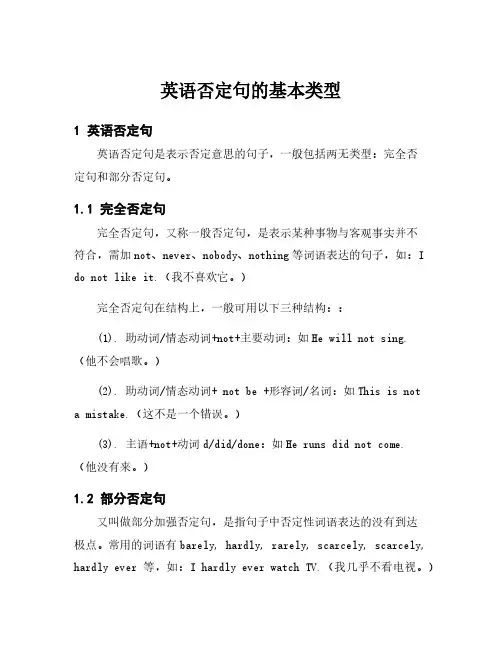
英语否定句的基本类型1 英语否定句英语否定句是表示否定意思的句子,一般包括两无类型:完全否定句和部分否定句。
1.1 完全否定句完全否定句,又称一般否定句,是表示某种事物与客观事实并不符合,需加not、never、nobody、nothing等词语表达的句子,如:I do not like it.(我不喜欢它。
)完全否定句在结构上,一般可用以下三种结构::(1). 助动词/情态动词+not+主要动词:如He will not sing.(他不会唱歌。
)(2). 助动词/情态动词+ not be +形容词/名词:如This is nota mistake.(这不是一个错误。
)(3). 主语+not+动词d/did/done:如He runs did not come.(他没有来。
)1.2 部分否定句又叫做部分加强否定句,是指句子中否定性词语表达的没有到达极点。
常用的词语有barely, hardly, rarely, scarcely, scarcely, hardly ever等,如:I hardly ever watch TV.(我几乎不看电视。
)部分否定句在结构上,也有三种:(1). 助动词/情态动词+hardly / scarcely/ rarely(almost不常用)+动词原形:如He can hardly speak English.(他几乎不会说英语。
)(2). 主语+hardly/scarcely/rarely(almost不常用)+动词过去式:如She rarely visited the park.(她很少去公园。
)(3). 主语+have/has+hardly/scarcely/rarely(almost不常用)+过去分词:如I have hardly taken the exam.(我几乎没参加过考试。
)以上就是英语中完全否定句和部分否定句的基本类型,当然还有很多否定句的表达方式,都是因人而异。
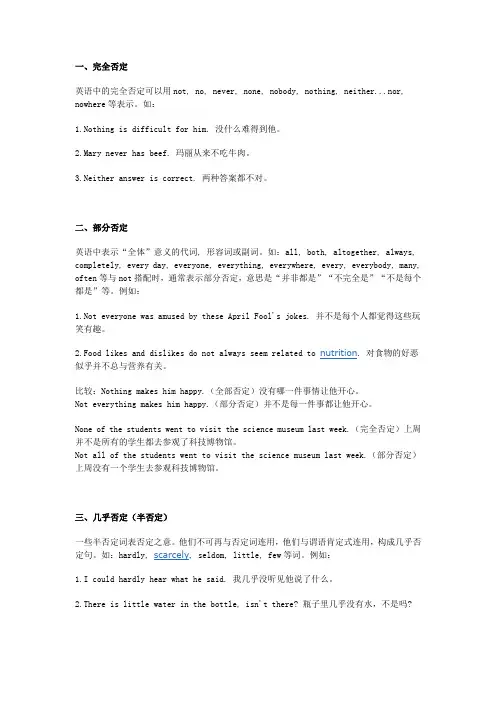
英语中的完全否定可以用not, no, never, none, nobody, nothing, neither...nor, nowhere等表示。
如:1.Nothing is difficult for him. 没什么难得到他。
2.Mary never has beef. 玛丽从来不吃牛肉。
3.Neither answer is correct. 两种答案都不对。
二、部分否定英语中表示“全体”意义的代词, 形容词或副词。
如:all, both, altogether, always, completely, every day, everyone, everything, everywhere, every, everybody, many, often等与not搭配时,通常表示部分否定,意思是“并非都是”“不完全是”“不是每个都是”等。
例如:1.Not everyone was amused by these April Fool's jokes. 并不是每个人都觉得这些玩笑有趣。
2.Food likes and dislikes do not always seem related to nutrition. 对食物的好恶似乎并不总与营养有关。
比较:Nothing makes him happy.(全部否定)没有哪一件事情让他开心。
Not everything makes him happy.(部分否定)并不是每一件事都让他开心。
None of the students went to visit the science museum last week.(完全否定)上周并不是所有的学生都去参观了科技博物馆。
Not all of the students went to visit the science museum last week.(部分否定)上周没有一个学生去参观科技博物馆。
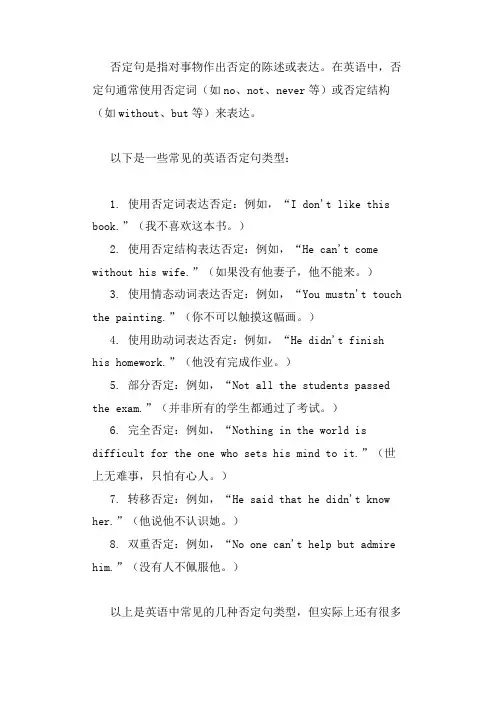
否定句是指对事物作出否定的陈述或表达。
在英语中,否定句通常使用否定词(如no、not、never等)或否定结构(如without、but等)来表达。
以下是一些常见的英语否定句类型:
1. 使用否定词表达否定:例如,“I don't like this book.”(我不喜欢这本书。
)
2. 使用否定结构表达否定:例如,“He can't come without his wife.”(如果没有他妻子,他不能来。
)
3. 使用情态动词表达否定:例如,“You mustn't touch the painting.”(你不可以触摸这幅画。
)
4. 使用助动词表达否定:例如,“He didn't finish his homework.”(他没有完成作业。
)
5. 部分否定:例如,“Not all the students passed the exam.”(并非所有的学生都通过了考试。
)
6. 完全否定:例如,“Nothing in the world is
diff icult for the one who sets his mind to it.”(世上无难事,只怕有心人。
)
7. 转移否定:例如,“He said that he didn't know her.”(他说他不认识她。
)
8. 双重否定:例如,“No one can't help but admire him.”(没有人不佩服他。
)
以上是英语中常见的几种否定句类型,但实际上还有很多
其他的表达方式。
在具体语境中,需要根据具体情况选择合适的表达方式。
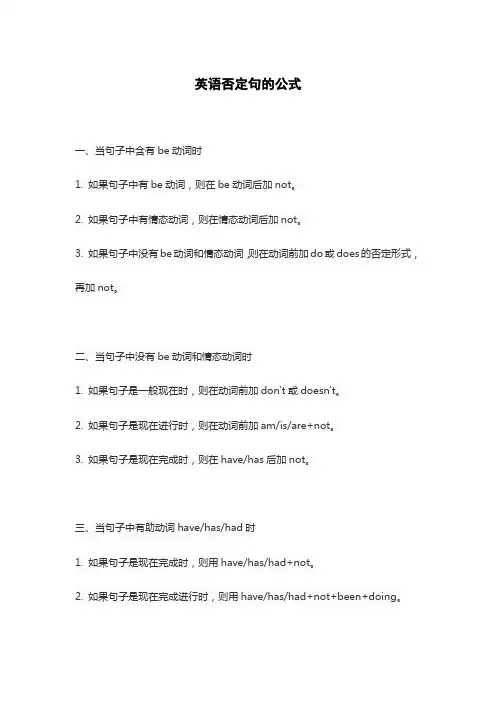
英语否定句的公式
一、当句子中含有be动词时
1. 如果句子中有be动词,则在be动词后加not。
2. 如果句子中有情态动词,则在情态动词后加not。
3. 如果句子中没有be动词和情态动词,则在动词前加do或does的否定形式,再加not。
二、当句子中没有be动词和情态动词时
1. 如果句子是一般现在时,则在动词前加don't或doesn't。
2. 如果句子是现在进行时,则在动词前加am/is/are+not。
3. 如果句子是现在完成时,则在have/has后加not。
三、当句子中有助动词have/has/had时
1. 如果句子是现在完成时,则用have/has/had+not。
2. 如果句子是现在完成进行时,则用have/has/had+not+been+doing。
四、当句子中有情态动词should/shouldn't时
1. 如果句子是should+动词原形,则用should+not+动词原形。
2. 如果句子是shouldn't+动词原形,则用shouldn't+动词原形。
五、当句子中有情态动词can/could/may/might时
1. 如果句子是can/could+动词原形,则用can't/couldn't+动词原形。
2. 如果句子是may/might+动词原形,则用may/might not+动词原形。
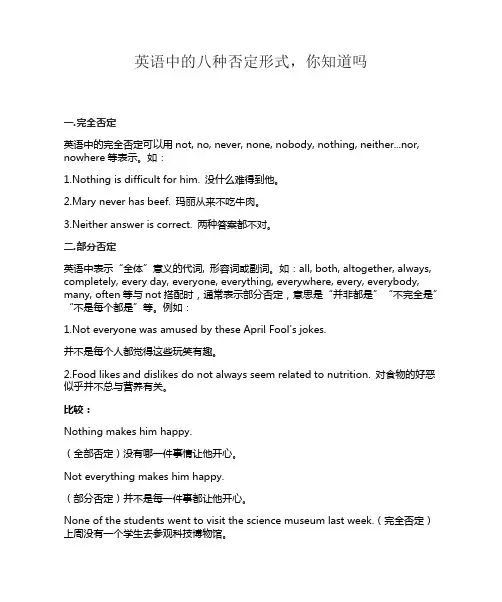
英语中的八种否定形式,你知道吗一.完全否定英语中的完全否定可以用not, no, never, none, nobody, nothing, neither...nor, nowhere等表示。
如:1.Nothing is difficult for him. 没什么难得到他。
2.Mary never has beef. 玛丽从来不吃牛肉。
3.Neither answer is correct. 两种答案都不对。
二.部分否定英语中表示“全体”意义的代词, 形容词或副词。
如:all, both, altogether, always, completely, every day, everyone, everything, everywhere, every, everybody, many, often等与not搭配时,通常表示部分否定,意思是“并非都是”“不完全是”“不是每个都是”等。
例如:1.Not everyone was amused by these April Fool's jokes.并不是每个人都觉得这些玩笑有趣。
2.Food likes and dislikes do not always seem related to nutrition. 对食物的好恶似乎并不总与营养有关。
比较:Nothing makes him happy.(全部否定)没有哪一件事情让他开心。
Not everything makes him happy.(部分否定)并不是每一件事都让他开心。
None of the students went to visit the science museum last week.(完全否定)上周没有一个学生去参观科技博物馆。
初中英语知识点归纳否定句的结构和否定词的用法初中英语知识点归纳:否定句的结构和否定词的用法在初中英语学习中,否定句是一个重要的语法知识点。
正确使用否定句可以帮助我们准确地表达否定的意思,增加语言表达的灵活性。
本文将对初中英语中的否定句结构和否定词的用法进行归纳总结,并介绍一些例句来帮助读者更好地理解。
一、否定句的基本结构初中英语中的否定句结构一般是由助动词或情态动词(如do、does、did、don't、doesn't、didn't、can't等)与动词的否定形式构成。
以下是一些常用的否定句结构:1. 否定一般现在时:主语 + 助动词(do/does)+ not + 动词原形例句:He does not like basketball.(他不喜欢篮球。
)We do not go to school on Sundays.(我们星期天不上学。
)2. 否定一般过去时:主语 + 助动词(did)+ not + 动词原形例句:She did not watch TV last night.(她昨晚没有看电视。
)They did not go to the park yesterday.(他们昨天没有去公园。
)3. 否定一般将来时:主语 + will not + 动词原形例句:I will not travel to Beijing next month.(我下个月不会去北京旅行。
)They will not come to the party tonight.(他们今晚不会来参加派对。
)4. 否定现在进行时:主语 + 助动词(am/is/are)+ not + 动词-ing 形式例句:I am not studying now.(我现在不在学习。
)They are not playing football in the park.(他们不在公园踢足球。
)5. 否定情态动词:主语 + 情态动词 + not + 动词原形例句:She can not swim.(她不会游泳。
英语否定概念的表达形式大致可分为两类:显形否定与隐形否定。
显形否定一般借助否定词或含否定意义的句型表达,其否定含义较为直观,故有明否定之称;隐形否定无明显否定词,其否定含义往往要靠上下文或语境来推定,比较难以把握,故有暗否定或间接否定之称。
一、显形否定常用否定词1.no,not,never,none,nobody,nothing,nowhere,neither,nor,neither...nor,but,without,unless,but for,but that,in the absence of,regardless of,instead of,exclusive of,short of,rather than,anything but,any more than,out of the question,would no more...than2.由a-,dis-,il-,im-,ir-,un-,non-,anti-,mal-,under-等前缀及-less,-free,-proof等后缀合成的否定词3.hardly,scarcely,barely,little,few,seldom等半否定词英语中有一种介于完全否定和部分否定之间的“否定”,即基本否定。
所谓基本否定就是在语气上将否定对象基本上否定,即百分之九十以上否定,肯定部分仅占很小部分。
比较:Nobody believes that.(完全否定)Hardly anybody believes that.(基本否定)Not all the people believe that.(部分否定)基本否定的表达方式主要是用不完全否定词hardly,scarcely,rarely,barely,seldom,few,little等,来表达否定意义。
这些词很接近never,not,no,none等词,不过语气较弱,而且在否定意义上留有余地,不象never ,no等词那样绝对。
小学初中英语各时态否定句用法总结唐赳原创抄袭必究对于初学者来说,英语的否定句的正确表达是一个难点。
今天在这里把各时态的否定句结构来总结一下以飨读者。
一、一般现在时态中的否定句:一般现在时态中的否定句分为两种类型:1)谓语动词是系动词is,am,are或者含有情态动词can,may,must,will,shall,could,would 等词时,其否定句是直接在这几个词后面加not。
(可以将not和这些词进行缩写:is not=isn’t,are not=aren’t ,can not=can’t,must not=mustn’t,will not=won’t,shall not =shan’t,could not =couldn’t,would not=wouldn’t。
)否定句结构为:主语+be not+... 或:主语+情态动词+动词原形+... 如:He is a student .他是一名学生。
(谓语是系动词be的肯定句)He is not a student . 他不是一名学生。
(否定句)He can sing English songs. 他会唱英语歌曲。
(谓语含有情态动词can的肯定句)He can not sing English songs. 他不会唱英语歌曲。
(否定句)2、谓语动词为行为动词(实义动词)时,否定句为:1)主语是第三人称单数时,否定句在does后加not,然后把第三人称单数形式的谓语动词还原成动词原形。
如:He likes reading. 他喜欢阅读。
(谓语动词为行为动词like)He doesn’t like reading. (does not 可缩写为doesn’t,单三动词还原,去掉s)2)主语是非第三人称单数时,否定句在do后面加not,do not 可缩略为:don’t.如:We like reading. 我们喜欢阅读。
(谓语为行为动词like 的肯定句)We don’t like reading. 我们不喜欢阅读。
2022年九年级中考英语语法知识梳理否定句否定句对人或事物加以否定的句子称为否定句。
英语的否定句大都用not来表示否定,不同的句子又有不同的否定形式。
1.含有be的否定句如果句子中含有连系动词或助动词be,句子的否定形式在be的后面直接加not。
如:He is not a student.他不是个学生。
We are not in the school.我们没在学校。
I'm not good at English.我不擅长英语。
He was not late for school that day.那天他上学没有迟到。
They were not doing their homework at that time.那时他们不是在做作业。
注意:在否定句中,be与not可以缩写。
is not→isn't;are not→aren't;was not→wasn't;were not→weren't2.含有助动词will,shall,would,have,has,had的否定句如果句子中含有助动词will,shall,would,have,has,had等,则在这些助动词后面直接加not构成否定句。
如:I have not been to the Great Wall.我没有去过长城。
He has not finished his homework yet.他还没有完成作业。
They will not have a meeting next week.下周他们不举行会议。
We would not go there with them.我们不愿意和他们一起去那里。
注意:在否定句中,助动词will,shall,would,have,has,had可与not缩写。
will not→won't;shall not→shan't;would not→wouldn't;havenot→haven't;has not→hasn't;had not→hadn't3.含有情态动词的否定句如果句子中含有情态动词can,may,must,need,could等,则在这些情态动词后直接加not构成否定句。
否定句子(Negative Sentences)1 否定句的基本规则在任何语言,我们都有必要造出〝否定〞的句子,在中文,写出否定句子并非难事,1.Verb to be 后面可以直接加not。
例如:He is not a good teacher.Mary was not very happy when she was young.They are not strong boys.Peter is not coming.John is not going to work.2.助动词后面可以直接加not。
例如:He has not written any letter.They will not come.He cannot swim.They should not cry very often.Tom had not eaten any thing before you came.He may never eat cakes in the future.John has not lived here.3.一般句子的动词必须加入do或他的变形。
He does not smoke.He did not go.I do not love sports.You do not like to eat fish.They do not swim very well.We did not see that movie.在英文中,我们可以用have to来代替must,以下是have to的例子:He has to go to Chicago tomorrow.(他明天应该去芝加哥)They had to buy three tickets to go to the concert.(他们必须买三张票去听音乐会)I have to work very hard.(我必须努力工作)含有have to的句子,如要改成否定句子,必须在have to前面加do或它的变形,请看以下的例子:练习将以下的肯定句子改成否定句子:1. I saw your brother last night.2. I like apples.3. She is a beautiful girl.4. They can play violin very well.5. Mr. Chang must answer the following questions.6. He went to see his brother last night.7. He could sing many songs.8. He will buy this car.9. It rained heavily last night.10. I have lived here for three years.11. He has to see his mother.12 . He had to stay here yesterday.2 No, Never和Any的用法要达成否定的意思,有时我们也可以用no和never这些字,no必须跟一个名词,请看下面的例子:1.I saw no students here.2.There are no lakes in this country.3.I have no money.4.I had no choice.5.He has no friends.以上这些例子也可以用not来表示否定的意思,如果用not,则以上的句子应该照下面的方式写;1.I did not see any student here.2.We can not find any lake in this country.3.I do not have any money.4.I did not have any choice.5.He does not have any friends.除以上not之外,never也可以表达否定的意思,以下都是never的例子,请注意never 常用在完成式的句子里:I have never gone there.He has never written any song.They have never washed their clothes.。
英语中的否定句exercises● 1. She is no fool.● 2. He is not incapable.● 3. She never comes without bringing some candy for the children.● 4. His pronunciation is not better than mine.● 5. His success is out of the question.● 6. His success is out of question.●7. we cannot exaggerate its importance.●8. I can’t help thinking that he is still alive.●9. It is an ill wind that blows nobody good.●10. They sent him to Coventry.● 1.她很聪明。
● 2. 他很能⼲。
● 3. 她每次来都给孩⼦们带糖果。
● 4. 他的发⾳和我的⼀样糟。
● 5. 他根本不可能成功。
● 6. 毫⽆疑问他会成功。
●7. 我们再怎么强调其重要性都不为过。
●8. 我不禁想到他肯能还活着。
●9. 再糟的事情也会有⼈受益。
●10. 他们都不理睬他。
否定句●There are not a few good sentences in his composition.●There is not a little water in the jar.●It wasn’t half hot there.●It isn’t half rainy today!●Your new car is not half bad.●(说明:not a half 的意思⽐较⿇烦,它⼀般表⽰“很,⾮常”,但如果它后⾯跟的词本⾝是表⽰贬义或否定的,那它的意思就是“⼀点也不”,所以最后⼀句话是:你的新车很不错。
否定句子(Negative Sentences)
1 否定句的基本规则
在任何语言,我们都有必要造出〝否定〞的句子,在中文,写出否定句子并非难事,
1.Verb to be 后面可以直接加not。
例如:
He is not a good teacher.
Mary was not very happy when she was young.
They are not strong boys.
Peter is not coming.
John is not going to work.
2.助动词后面可以直接加not。
例如:
He has not written any letter.
They will not come.
He cannot swim.
They should not cry very often.
Tom had not eaten any thing before you came.
He may never eat cakes in the future.
John has not lived here.
3.一般句子的动词必须加入do或他的变形。
He does not smoke.
He did not go.
I do not love sports.
You do not like to eat fish.
They do not swim very well.
We did not see that movie.
在英文中,我们可以用have to来代替must,以下是have to的例子:
He has to go to Chicago tomorrow.(他明天应该去芝加哥)
They had to buy three tickets to go to the concert.(他们必须买三张票去听音乐会)
I have to work very hard.(我必须努力工作)
含有have to的句子,如要改成否定句子,必须在have to前面加do或它的变形,请看以下的例子:
练习
将以下的肯定句子改成否定句子:
1. I saw your brother last night.
2. I like apples.
3. She is a beautiful girl.
4. They can play violin very well.
5. Mr. Chang must answer the following questions.
6. He went to see his brother last night.
7. He could sing many songs.
8. He will buy this car.
9. It rained heavily last night.
10. I have lived here for three years.
11. He has to see his mother.
12 . He had to stay here yesterday.
2 No, Never和Any的用法
要达成否定的意思,有时我们也可以用no和never这些字,no必须跟一个名词,请看下面的例子:
1.I saw no students here.
2.There are no lakes in this country.
3.I have no money.
4.I had no choice.
5.He has no friends.
以上这些例子也可以用not来表示否定的意思,如果用not,则以上的句子应该照下面的方式写;
1.I did not see any student here.
2.We can not find any lake in this country.
3.I do not have any money.
4.I did not have any choice.
5.He does not have any friends.
除以上not之外,never也可以表达否定的意思,以下都是never的例子,请注意never 常用在完成式的句子里:
I have never gone there.
He has never written any song.
They have never washed their clothes.。